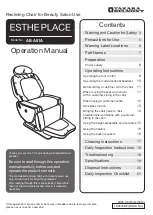
5
RockShox® Service
R o c k S h o x ® S e r v i c e
We recommend that you have your RockShox suspension serviced by a qualified bicycle mechanic. Servicing RockShox suspension requires
knowledge of suspension components, as well as the use of specialized tools and lubricants/fluids. Failure to follow the procedures outlined in this
service manual may cause damage to your component and void the warranty.
Visit
www.sram.com/service
for the latest RockShox Spare Parts catalog and technical information. For order information, please contact your local
SRAM® distributor or dealer.
Information contained in this publication is subject to change at any time without prior notice.
Your product's appearance may differ from the pictures contained in this publication.
For recycling and environmental compliance information, please visit
www.sram.com/company/environment
.
P a r t P r e p a r a t i o n
Remove the component from the bicycle before service.
Disconnect and remove the remote cable or hydraulic hose from the fork or rear shock, if applicable. For additional information about RockShox
remotes, user manuals are available at
www.sram.com/service
.
Clean the exterior of the product with mild soap and water to avoid contamination of internal sealing part surfaces.
S e r v i c e P r o c e d u r e s
The following procedures should be performed throughout service, unless otherwise specified.
Clean the part with isopropyl alcohol or RockShox Suspension Cleaner and
a clean, lint-free shop towel. For hard to reach places (e.g. upper tube, lower
leg), wrap a clean, lint-free shop towel around a non-metallic dowel to clean
the inside.
Clean the sealing surface on the part and inspect it for scratches.
Replace the o-ring or seal with a new one from the service kit. Use your
fingers or a pick to pierce and remove the old seal or o-ring.
Apply
only
SRAM Butter grease to the new seal or o-ring.
NOTICE
Do not scratch any sealing surfaces when servicing the product. Scratches
can cause leaks. Consult the spare parts catalog to replace the damaged
part.
Use aluminum soft jaws when placing a part in a bench vise.
Tighten the part with a torque wrench to the torque value listed in the red bar.
When using a crowfoot socket and torque wrench, install the crowfoot socket
at 90 degrees to the torque wrench.
Specified torque value in N·m (in-lb)






































